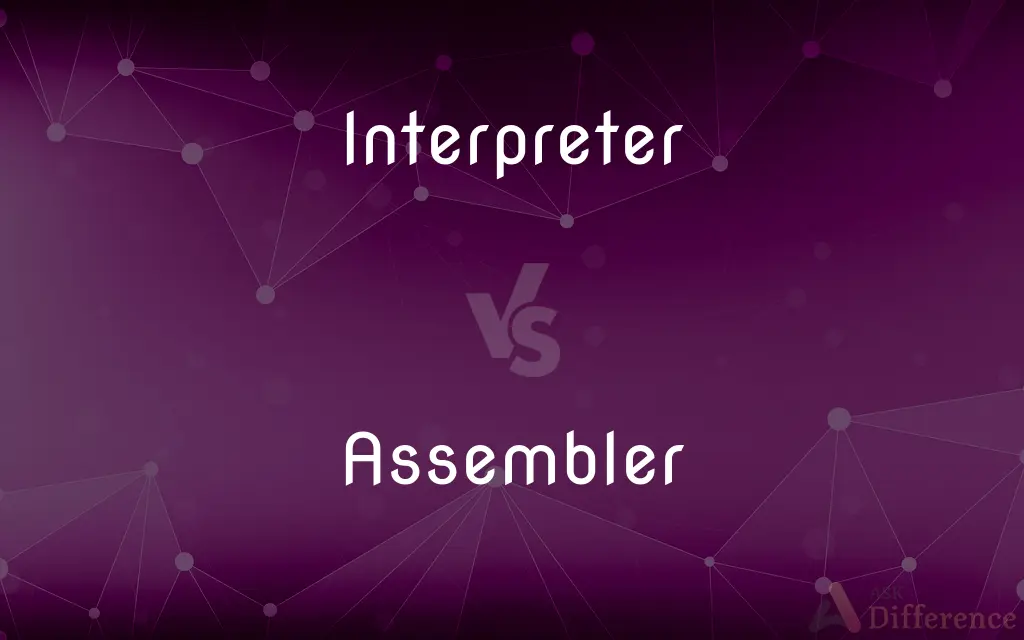Interpreter vs. Assembler — What's the Difference?
Edited by Tayyaba Rehman — By Fiza Rafique — Published on December 8, 2023
An Interpreter translates and executes high-level programming code line-by-line, whereas an Assembler converts assembly language programs into machine code.

Difference Between Interpreter and Assembler
Table of Contents
ADVERTISEMENT
Key Differences
An Interpreter is a tool that translates and executes high-level programming code line-by-line during runtime, which means the code is executed as it's being read. Conversely, an Assembler takes assembly language programs and translates them into machine code, which the computer's hardware can directly execute.
When using an Interpreter, the source code isn't permanently converted into machine code. Instead, it's translated every time the program runs. On the other hand, an Assembler provides a one-time translation, producing a binary file that can be executed multiple times without requiring re-assembly.
The speed of code execution can be slower with an Interpreter since translation and execution happen simultaneously. In contrast, once an Assembler has translated the assembly code into machine code, that code runs at the speed of the machine's hardware, usually much faster.
Interpreter tools are commonly used with languages like Python and JavaScript. They offer the advantage of ease of debugging because errors are found one line at a time. In the world of an Assembler, assembly language, which is a low-level representation of machine code, is used, giving programmers a closer insight into the hardware.
Both Interpreter and Assembler have specific roles in the software development process. While Interpreters offer flexibility and ease of modification, Assemblers allow for direct control over the hardware and optimized performance.
ADVERTISEMENT
Comparison Chart
Function
Translates and executes code line-by-line during runtime
Converts assembly code into machine code
Speed
Slower (translation & execution are simultaneous)
Faster (after initial translation)
Code Type
High-level programming languages
Assembly language
Permanent Conversion to Machine Code
No
Yes
Typical Languages
Python, JavaScript
Assembly language
Compare with Definitions
Interpreter
Used for languages that prioritize ease of modification and debugging.
JavaScript uses an Interpreter to run in web browsers.
Assembler
Offers a low-level representation of machine code.
Using an Assembler gives developers deeper insight into hardware operations.
Interpreter
Executes code without a prior conversion to machine code.
With an Interpreter, developers can quickly test and debug their code.
Assembler
A tool that translates assembly language into machine code.
The Assembler produced a binary file from the assembly source code.
Interpreter
A tool that translates high-level programming code during runtime.
The Python Interpreter executes Python scripts line by line.
Assembler
Provides a one-time conversion of code.
Once the Assembler finishes, the machine code can be executed repeatedly.
Interpreter
Processes source code line-by-line.
If there's an error in the code, the Interpreter will halt at that line.
Assembler
Creates a binary executable from assembly source.
After the Assembler's translation, the code can run directly on the computer's CPU.
Interpreter
Enables immediate code execution without compilation.
Programmers use an Interpreter to see instant results of their code modifications.
Assembler
Used for direct hardware control and optimization.
Assembly language, processed by an Assembler, offers precise hardware control.
Interpreter
One who translates orally from one language into another.
Assembler
One that assembles, as a worker who puts together components of an item being manufactured.
Interpreter
One who gives or expounds an interpretation
"An actor is an interpreter of other men's words, often a soul which wishes to reveal itself to the world" (Alec Guinness).
Assembler
(Computers) A program that produces executable machine code from symbolic assembly language.
Interpreter
(Computers) A program that executes other programs.
Assembler
A program that reads source code written in assembly language and produces executable machine code, possibly together with information needed by linkers, debuggers and other tools.
Interpreter
A person who interprets.
An interpreter of dreams
One of the foremost interpreters [i.e. performers] of Beethoven's piano works
Assembler
Assembly language.
I wrote that program in assembler.
Interpreter
A person who converts spoken or signed language into a different language for the benefit of one or more others who do not understand the first language being used (especially if in real time or shortly after that person has finished communicating). translator.}}
A Japanese man who is tried before a German court is assisted by an interpreter in making oral statements.
Assembler
(countable) One who assembles items.
Interpreter
A guide who helps people visiting an attraction such as an art exhibit, a nature reserve, etc., understand what they are seeing.
Assembler
A nanodevice capable of assembling nanodevices, possibly including copies of itself, according to a plan.
Interpreter
(figuratively) Something that reveals or clarifies.
Assembler
One who assembles a number of individuals; also, one of a number assembled.
Interpreter
(computing) A program that executes another program written in a high-level language by reading the instructions in real time rather than by compiling it in advance.
Programs written in the BASIC language are usually run through an interpreter, though some can be compiled.
Assembler
A computer program that takes as input a set of instructions written in assembly language, and produces a corresponding executable computer program in machine language.
Interpreter
One who or that which interprets, explains, or expounds; a translator; especially, a person who translates orally between two parties.
We think most men's actions to be the interpreters of their thoughts.
Assembler
Same as assembly language.
Interpreter
Someone who mediates between speakers of different languages
Assembler
A program to convert assembly language into machine language
Interpreter
Someone who uses art to represent something;
His paintings reveal a sensitive interpreter of nature
She was famous as an interpreter of Shakespearean roles
Interpreter
An advocate who represents someone else's policy or purpose;
The meeting was attended by spokespersons for all the major organs of government
Interpreter
(computer science) a program that translates and executes source language statements one line at a time
Common Curiosities
How does an Assembler function?
An Assembler translates assembly language programs into machine code.
Why might code run slower in an Interpreter?
With an Interpreter, translation and execution happen simultaneously, potentially slowing execution.
What does an Interpreter do?
An Interpreter translates and executes high-level programming code line-by-line during runtime.
When would one use an Assembler?
An Assembler is used when working with assembly language for direct hardware control and optimization.
Does an Assembler work with high-level languages like Python?
No, an Assembler works with assembly language, a low-level representation of machine code.
Why might someone choose to use an Interpreter?
Interpreters offer flexibility, ease of modification, and simpler debugging processes.
What kind of code is directly executed by the computer's CPU?
Machine code, which can be produced by an Assembler, is directly executed by the CPU.
Are changes to code instantly reflected with an Interpreter?
Yes, changes in code can be immediately executed and tested with an Interpreter.
Do Interpreters produce a standalone executable file?
No, Interpreters translate and execute code on-the-fly without producing a permanent executable.
Are errors easier to identify with an Interpreter?
Generally, yes, because Interpreters process code line-by-line and can halt on encountering an error.
Which tool, Interpreter or Assembler, offers a deeper connection to computer hardware?
The Assembler, because it processes assembly language, which is closely tied to hardware operations.
Is assembly language close to machine code?
Yes, assembly language, processed by an Assembler, is a human-readable representation of machine code.
Can you provide an example of a language that uses an Interpreter?
Yes, Python and JavaScript are examples of languages that use Interpreters.
Can an Interpreter run without the original source code?
No, an Interpreter requires the source code every time it runs the program.
Is the output of an Assembler the final executable?
Yes, an Assembler produces machine code, which can be executed directly by the computer's hardware.
Share Your Discovery

Previous Comparison
HashMap vs. HashSet
Next Comparison
Chromium Picolinate vs. Chromium PolynicotinateAuthor Spotlight
Written by
Fiza RafiqueFiza Rafique is a skilled content writer at AskDifference.com, where she meticulously refines and enhances written pieces. Drawing from her vast editorial expertise, Fiza ensures clarity, accuracy, and precision in every article. Passionate about language, she continually seeks to elevate the quality of content for readers worldwide.
Edited by
Tayyaba RehmanTayyaba Rehman is a distinguished writer, currently serving as a primary contributor to askdifference.com. As a researcher in semantics and etymology, Tayyaba's passion for the complexity of languages and their distinctions has found a perfect home on the platform. Tayyaba delves into the intricacies of language, distinguishing between commonly confused words and phrases, thereby providing clarity for readers worldwide.














































